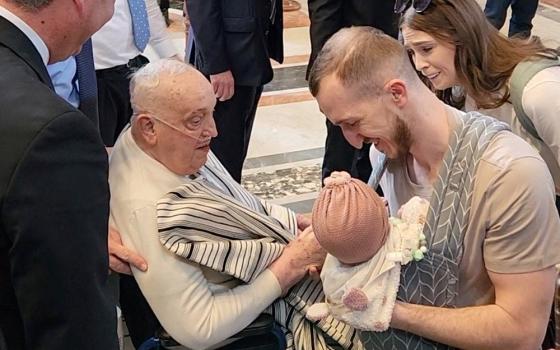
Joanna Kulig in “The Innocents” (Courtesy of Music Box Films)
At last, the long night of World War II is over in Europe, but for a Benedictine monastery of nuns in northern Poland, the nightmare continues. During vespers one evening, a white-veiled novice hears screaming. She puts on her coat against the cold and snow and, sneaking out a hidden door, runs across the fields to a nearby town.
There, she asks a street urchin to take her to a doctor -- just not one who is Russian or Polish. The young boy leads her to the French Red Cross, where the staff is caring for French citizens who had been in concentration camps and are now awaiting repatriation.
The novice finds a young Frenchwoman, Mathilde (Lou de Laâge). Though only a medical volunteer with little experience, she commandeers one of the Red Cross tucks and drives with the young sister back to the convent. There, Mathilde discovers another novice about to give birth.
Although a communist and nonbeliever, she knows something is terribly wrong. Soon Mathilde finds out from Sister Maria (Agata Buzek) that when the Soviet army swept through Poland toward the end of the war, soldiers invaded the convent and spent three days raping and assaulting the nuns. Nine months later, at least seven are in late stages of pregnancy.
“The Innocents” (originally titled “Agnus Dei”) is a profoundly disturbing film in every way: human, spiritual, religious, psychological and cultural. It progresses through every human emotion and reaction you can imagine in the wake of great trauma and psycho-spiritual pain that remains emotionally suppressed, with the effects hidden under the robes the sisters wear. Then the film gently surprises us at the end in ways that are credible, hopeful and remarkably heroic.
Philippe Maynial developed the story from actual notes made by his aunt, the real-life Red Cross doctor Madeleine Pauliac (1912-46). (While these notes are not available, click here for an interview in French with Maynial; use Google Translate to read it in English.)
Noted French director Anne Fontaine adapted it and created some of the dialogue for the screenwriters. The filmmakers found an abandoned monastery to use as the setting. The cinematography skillfully creates a cold environment warmed by women’s humanity.
Sister Maria is the prioress who assists the stern Mother Abbess (Agata Kulesza). They scold and punish the brave novice for leaving the convent to go for help. Actually, the two senior women are terrified that their secret will get out, bringing shame and consequences upon them from the townspeople and the families that support the monastery.
It is obvious that the abbess is having a hard time handling the situation; she is dark and unyielding. The abbess’ main concern is to find a way to deal with the babies that are coming. The nuns are also frightened of a return of the Red Army, because this time the soldiers will surely kill them -- they barely escaped death after the terror they endured.
The nuns and novices do not want Mathilde to touch or examine them because of their vow of chastity and because of their trauma. Maria explains to Mathilde that it was harder for them because they were virgins; she herself had had a boyfriend before she entered the community.
There is also tension about obedience, as the nuns must navigate a literal interpretation of the monastic rule with the demands of their pregnancies, the new lives in their midst, their suffering, fear and mistrust.
When Mathilde delivers the first baby, the abbess explains she will place the infant with the novice’s family -- because they will have room for an abandoned child left at the convent. But the abbess, herself suffering from syphilis, feels compelled to do something in secret to protect the reputation of the sisters and the convent.
The film implies strongly that sisters know how their fellow Catholics treat illegitimate babies and unwed mothers, and the fact that the offenders are nuns will make this a scandal the monastery will not survive. When the sisters confront the abbess about her actions, she replies that she lost her soul to save their honor. This confusion of moral priorities is shocking, but their whole world is now a clash of morals and mores. How the community deals with the abbess’ actions is pure mercy.
Mathilde must return to the monastery when another sister is in labor, though she faces disciplinary action because she again takes the vehicle without permission and is always late.
Swearing a doctor (Vincent Macaigne) to secrecy, she brings him with her to help when two other women are in labor. The nuns do not want him because he is a man -- and a Jew. (In real life, a priest was part of Pauliac’s Red Cross team.) They allow him finally to enter because they need a doctor; herbs are not enough to cure what they have.
Events like this continue in modern times (notably in Bosnia and Serbia in the 1990s, more recently in Africa and the reality of human sex trafficking and slavery). We would probably rather not think about the consequences. The film takes on the horror of this war crime as only cinema can, contrasting the ugly with beauty, the guilty and the innocent in a fine balance between the humanity of art and the inhumanity of people.
“The Innocents” is a challenging film to watch as a woman and as a woman religious. The sisters have no chaplain so there is no Mass or spiritual guidance except their praying the Hours. To put it in perspective: It’s the direst episode of NBC’s “Law & Order: Special Victims Unit” meets an incredible episode of PBS’ “Call the Midwife.”
The film is a noteworthy historical drama because it tells an excruciating story with minimal dialogue and avoids the temptation to revisit the initial assault except through Sister Maria’s all-knowing narration.
Director Fontaine keeps the action focused in the narrow locations of a monastery without physical comfort and the Red Cross center filled with people about to go home, those who will leave the confines of their sorrow and begin again. She asks us to consider if this is possible or at what cost to the women can this happen in a closed monastery.
Fontaine stays true to her characters; she ventures out only to show us the frozen landscape, a bleak village with orphaned children and a barren farm.
Finally, at the end, we can breathe again and marvel at these women of grace and courage. If we frame the film using a prayerful lectio divina approach, we come to actio -- what action does the film ask of us for today?
[Sr. Rose Pacatte, a member of the Daughters of St. Paul, is the director of the Pauline Center for Media Studies in Los Angeles.]




